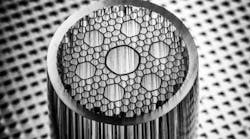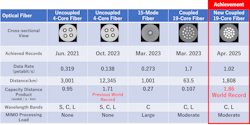Fiber’s physical evolutions
By Gary Bolton / Fiber Broadband Association
Today’s medium of fiber is already an amazing feat of engineering. Consider for a moment that single strand of fiber placed under the Pacific Ocean over 20 years ago now carries 1.2 Tbps, with shorter-distance spans carrying up to 1.6 Tbps. Fiber-to-the-Home (FTTH) services built around 100 Mbps speeds at the beginning of the century are now being upgraded to 25G and 50G PON and will support 200G PON in the next upgrade cycle.
Fiber continues to deliver ever-increasing speeds at lower costs and latency, and in a highly reliable, robust, and secure fashion.
CableLabs believes that today’s “in the ground” fiber can support speeds up to 50,000 Gbps sometime in the future, but there are significant users that are looking to improve fiber’s utility, density, and performance to new heights today.
Smaller fiber options
There are various paths for improving fiber that are quietly (and sometimes not-so-quietly) being built today. One path is making the fiber physically smaller. Traditional single-mode fiber is 242 microns (micrometers) in diameter, already small. In comparison, a single human hair can be roughly 50 to 100 microns.
Today, Corning and others are offering a 200-micron-diameter single-strand fiber, a small change that adds up quickly. Smaller is better across all applications from residences to the enterprise, since it enables installers to put more fiber into more places, increasing fiber count in capacity-strained conduits, lightening the load for aerial deployments, and making already-discreet deployment of fiber into offices and multi-dwelling units (MDUs) that much easier.
Where the smaller diameter really shines is in the AI data center. The need for higher-density computing to build the next generation of AI makes every cubic inch of space precious as racks, servers, and increasingly individual chips get their own dedicated communications channels.
The only drawback to smaller diameter fiber is having to splice it with existing larger diameter fiber. Some specialized tools are needed, and fiber technicians need to be trained in the how-tos, but this is not a significant challenge.
HCF and MCF emerge
Hollow core fiber (HCF) that guides laser light through air or vacuum rather than glass is the next big step for the medium. Very simply, light travels more slowly through glass than through the empty hollow core tube (wave guide) and glass also limits the number of optical frequencies that can be used for data transmission. If single-mode fiber is a standard highway, hollow core is the autobahn, decreasing latency and increasing transmission distance today, with the potential to further increase speeds in the future.
By using HCF, transmission speeds can increase by 47%, and latency can be cut by 33%. In addition, lower signal loss means fewer repeaters are needed for any given distance, translating to lower energy usage. Initial amounts of HCF have been produced and deployed over the past five years for reducing latency between offices or data centers at short distances, while manufacturers perfected the media to improve its loss characteristics so it would equal or exceed that of traditional fiber.
In 2022, Microsoft acquired HCF manufacturer Lumenisity, which subsequently started producing HCF in the UK and drove further HCF research. Last year, the company announced it would deploy 15,000 kilometers of HCF across its Azure data center network in two years to support AI connectivity. This year, Microsoft announced it had figured out how to make HCF with loss characteristics exceeding that of fiber, essentially opening the door to large-scale production.
But it hasn’t stopped there. In late September 2025, Microsoft announced it was working to establish additional “industrial scale-up of HCF production” with Corning and Heraeus Covantics to feed the need for the material for its data centers. We can expect other fiber manufacturers to start cranking up their HCF production and promoting the use of the medium in data centers and other applications.
To be sure, there is still plenty of work ahead in moving HCF into the mainstream. It will require building a cadre of fiber technicians skilled in working with and splicing the media, new tools and standards, and the tradeoffs between using standard fiber and the more expensive but better-performing HCF. Microsoft is working with Corning and Heraeus on all these issues as part of an effort to build a standardized global ecosystem to support HCF at scale for deployment into carrier environments.
HCF also has implications for quantum computing, by extending the distance qubits can be sent without the need for additional equipment, such as routers or repeaters, devices that currently don’t exist for quantum networking. When such devices are created, they will initially cost more than existing network gear. HCF should reduce the need for quantum networking gear when it arrives, saving money and accelerating the time to deployment.
Multi-core optical fiber (MCF) is the third path for fiber to create more bandwidth, putting multiple light-guiding cores into a single strand of optical fiber, enabling the simultaneous transmission of more signals along one strand. MCF increases fiber density and bandwidth, with manufacturers such as Lightera and Sumitomo Electric working to refine and productize it for general use.
There have been some very dramatic demonstrations of multi-core technology. Earlier this year, Sumitomo and Japan’s National Institute of Information and Communications Technology announced a world record by using a 19-core optical fiber to transmit over 1 petabytes per second across over 1,800 kilometers, the distance from Missouri to Montana. Closer to deployment, Lightera is sampling MCF solutions to select customers and has shown it can produce anywhere from 4-core to 8-core fiber.
MCF has a wide variety of applications, including subsea and terrestrial connectivity, and for data center applications to provide high-density, high-speed connectivity between switches, servers, and storage devices. Lightera has demonstrated the ability to support 8-core MCF at 800 Gbps for short-distance applications and 4-core MCF at 400 Gbps for distances of 10 kilometers.
However, MCF comes with its own challenges, like hollow core. While there is an MCF working group in the Advanced Photonics Coalition, they have not yet established standards for basic characteristics such as the number of cores, core layout, and cladding diameter, making every current field deployment of MCF a customized build. Specialized tools need to be built for multi-core splicing, especially to make sure that it can be spliced quickly, with low loss, and high strength. Finally, you need trained MCF technicians who preferably follow and adhere to established standards.
Still, as MCF matures, it will take its place next to standard fiber and HFC, providing more network options to data centers, hyperscalers, cloud and service providers, and enterprises. Perhaps the most forward-thinking observation I can offer is that network planners should think carefully about the future balance between deployed fiber and available conduit to roll out a new solution should customers need it, such as HFC or MCF.
Traditional single-strand fiber isn’t going anywhere, but it’s always nice to be able to provide options for power users seeking lower latency, higher density, and/or more sheer bandwidth.
Gary Bolton is president and CEO of the Fiber Broadband Association, the largest trade association dedicated to all-fiber broadband. Before FBA, Gary held executive management positions in marketing, product line management, and public policy at two successful venture-backed high-tech start-ups and large publicly traded companies. He holds an MBA from Duke University and a BS in Electrical Engineering from North Carolina State University.



